Detailed Analysis of Business Resources and Finance at ASDA
VerifiedAdded on 2020/07/23
|10
|3038
|30
Report
AI Summary
This report provides a comprehensive analysis of ASDA's business resources, encompassing recruitment documentation, required employability, personal, and communication skills for a customer service manager role. It examines physical and technological resources essential for ASDA's operations, including building infrastructure, equipment, and software. Furthermore, the report delves into ASDA's financial aspects, covering internal and external sources of finance, the interpretation of trading, profit & loss accounts, and balance sheets, and the utilization of budgets for financial control. The report also includes an interpretation of financial statements and explains how budgets are used to exercise financial control. The analysis covers ASDA's financial performance, providing valuable insights into the company's resource management and financial strategies.
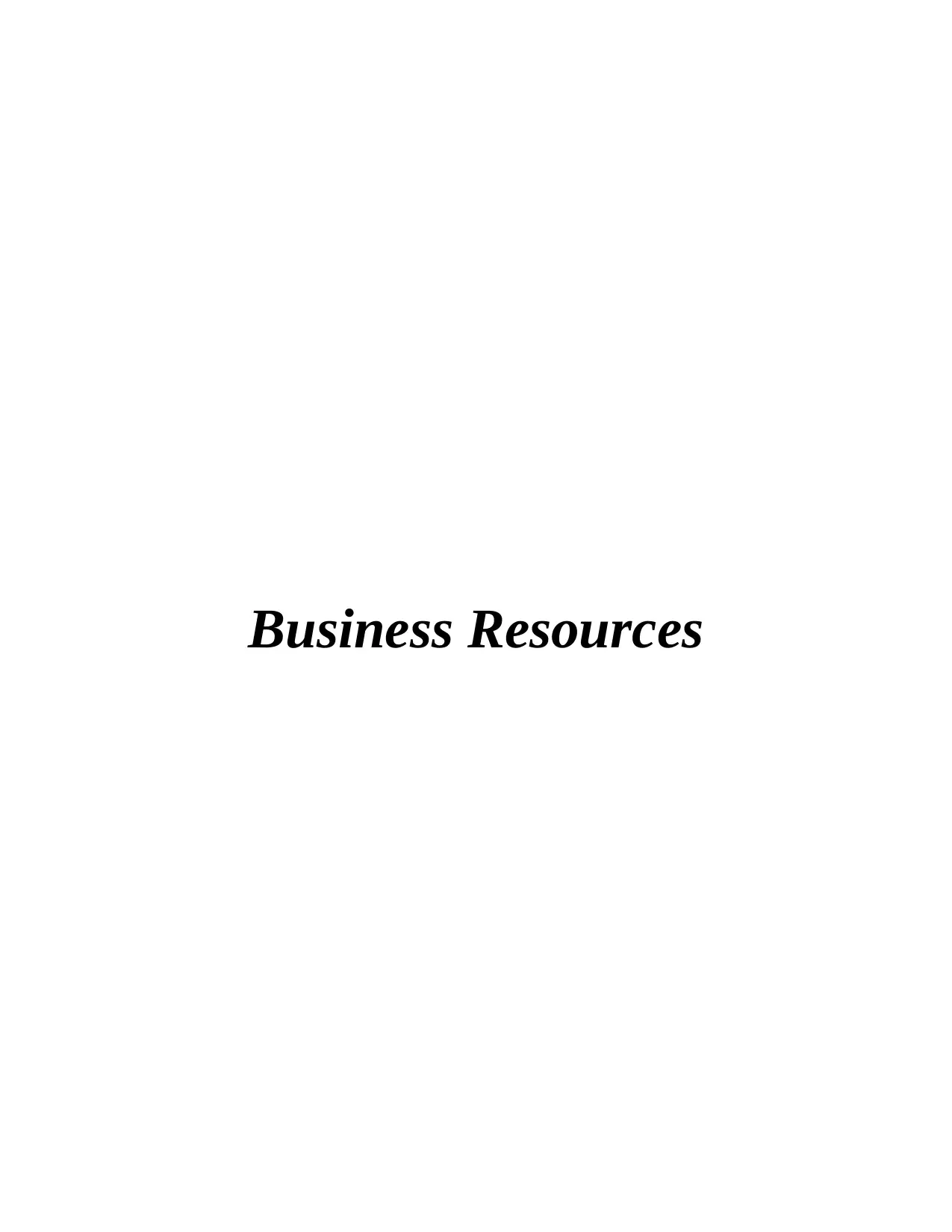
Business Resources
Paraphrase This Document
Need a fresh take? Get an instant paraphrase of this document with our AI Paraphraser

Table of Contents
INTRODUCTION...........................................................................................................................1
TASK 1............................................................................................................................................1
P1- The recruitment documentation used in a selected organisation.....................................1
P2- Employability, personal and communication skills required when applying for a specific
job...........................................................................................................................................1
TASK 2............................................................................................................................................3
P3- Physical and technological resources required in operation of ASDA............................3
TASK 3............................................................................................................................................3
P4- Sources of internal and external finance..........................................................................3
P5- Interpretation of contents of trading, profit & loss account and balance sheet of ASDA4
P6- Use of budgets as a means of exercising financial control..............................................5
P7 Illustrate the financial state of a given business................................................................6
CONCLUSION................................................................................................................................6
REFERENCES................................................................................................................................8
.........................................................................................................................................................8
INTRODUCTION...........................................................................................................................1
TASK 1............................................................................................................................................1
P1- The recruitment documentation used in a selected organisation.....................................1
P2- Employability, personal and communication skills required when applying for a specific
job...........................................................................................................................................1
TASK 2............................................................................................................................................3
P3- Physical and technological resources required in operation of ASDA............................3
TASK 3............................................................................................................................................3
P4- Sources of internal and external finance..........................................................................3
P5- Interpretation of contents of trading, profit & loss account and balance sheet of ASDA4
P6- Use of budgets as a means of exercising financial control..............................................5
P7 Illustrate the financial state of a given business................................................................6
CONCLUSION................................................................................................................................6
REFERENCES................................................................................................................................8
.........................................................................................................................................................8
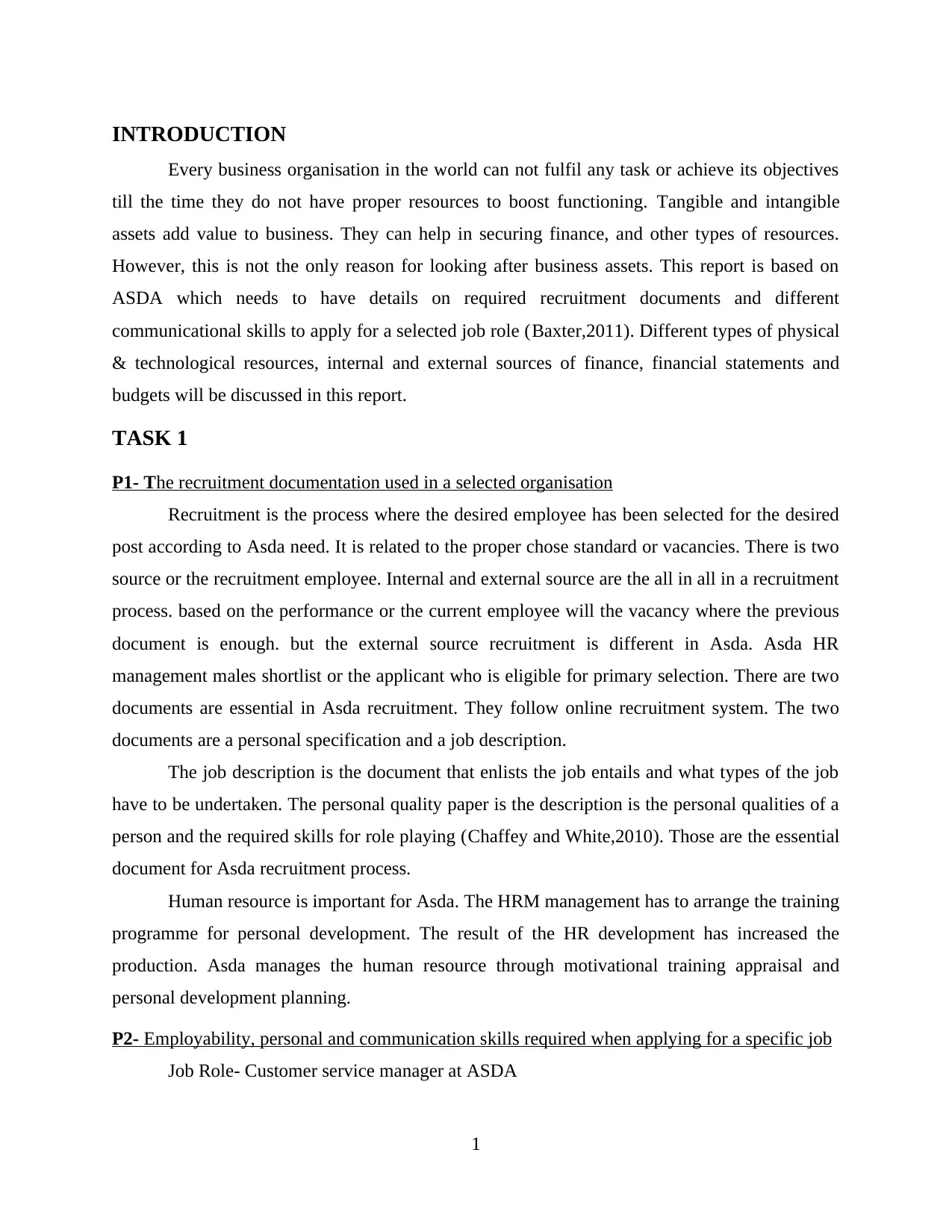
INTRODUCTION
Every business organisation in the world can not fulfil any task or achieve its objectives
till the time they do not have proper resources to boost functioning. Tangible and intangible
assets add value to business. They can help in securing finance, and other types of resources.
However, this is not the only reason for looking after business assets. This report is based on
ASDA which needs to have details on required recruitment documents and different
communicational skills to apply for a selected job role (Baxter,2011). Different types of physical
& technological resources, internal and external sources of finance, financial statements and
budgets will be discussed in this report.
TASK 1
P1- The recruitment documentation used in a selected organisation
Recruitment is the process where the desired employee has been selected for the desired
post according to Asda need. It is related to the proper chose standard or vacancies. There is two
source or the recruitment employee. Internal and external source are the all in all in a recruitment
process. based on the performance or the current employee will the vacancy where the previous
document is enough. but the external source recruitment is different in Asda. Asda HR
management males shortlist or the applicant who is eligible for primary selection. There are two
documents are essential in Asda recruitment. They follow online recruitment system. The two
documents are a personal specification and a job description.
The job description is the document that enlists the job entails and what types of the job
have to be undertaken. The personal quality paper is the description is the personal qualities of a
person and the required skills for role playing (Chaffey and White,2010). Those are the essential
document for Asda recruitment process.
Human resource is important for Asda. The HRM management has to arrange the training
programme for personal development. The result of the HR development has increased the
production. Asda manages the human resource through motivational training appraisal and
personal development planning.
P2- Employability, personal and communication skills required when applying for a specific job
Job Role- Customer service manager at ASDA
1
Every business organisation in the world can not fulfil any task or achieve its objectives
till the time they do not have proper resources to boost functioning. Tangible and intangible
assets add value to business. They can help in securing finance, and other types of resources.
However, this is not the only reason for looking after business assets. This report is based on
ASDA which needs to have details on required recruitment documents and different
communicational skills to apply for a selected job role (Baxter,2011). Different types of physical
& technological resources, internal and external sources of finance, financial statements and
budgets will be discussed in this report.
TASK 1
P1- The recruitment documentation used in a selected organisation
Recruitment is the process where the desired employee has been selected for the desired
post according to Asda need. It is related to the proper chose standard or vacancies. There is two
source or the recruitment employee. Internal and external source are the all in all in a recruitment
process. based on the performance or the current employee will the vacancy where the previous
document is enough. but the external source recruitment is different in Asda. Asda HR
management males shortlist or the applicant who is eligible for primary selection. There are two
documents are essential in Asda recruitment. They follow online recruitment system. The two
documents are a personal specification and a job description.
The job description is the document that enlists the job entails and what types of the job
have to be undertaken. The personal quality paper is the description is the personal qualities of a
person and the required skills for role playing (Chaffey and White,2010). Those are the essential
document for Asda recruitment process.
Human resource is important for Asda. The HRM management has to arrange the training
programme for personal development. The result of the HR development has increased the
production. Asda manages the human resource through motivational training appraisal and
personal development planning.
P2- Employability, personal and communication skills required when applying for a specific job
Job Role- Customer service manager at ASDA
1
⊘ This is a preview!⊘
Do you want full access?
Subscribe today to unlock all pages.

Trusted by 1+ million students worldwide
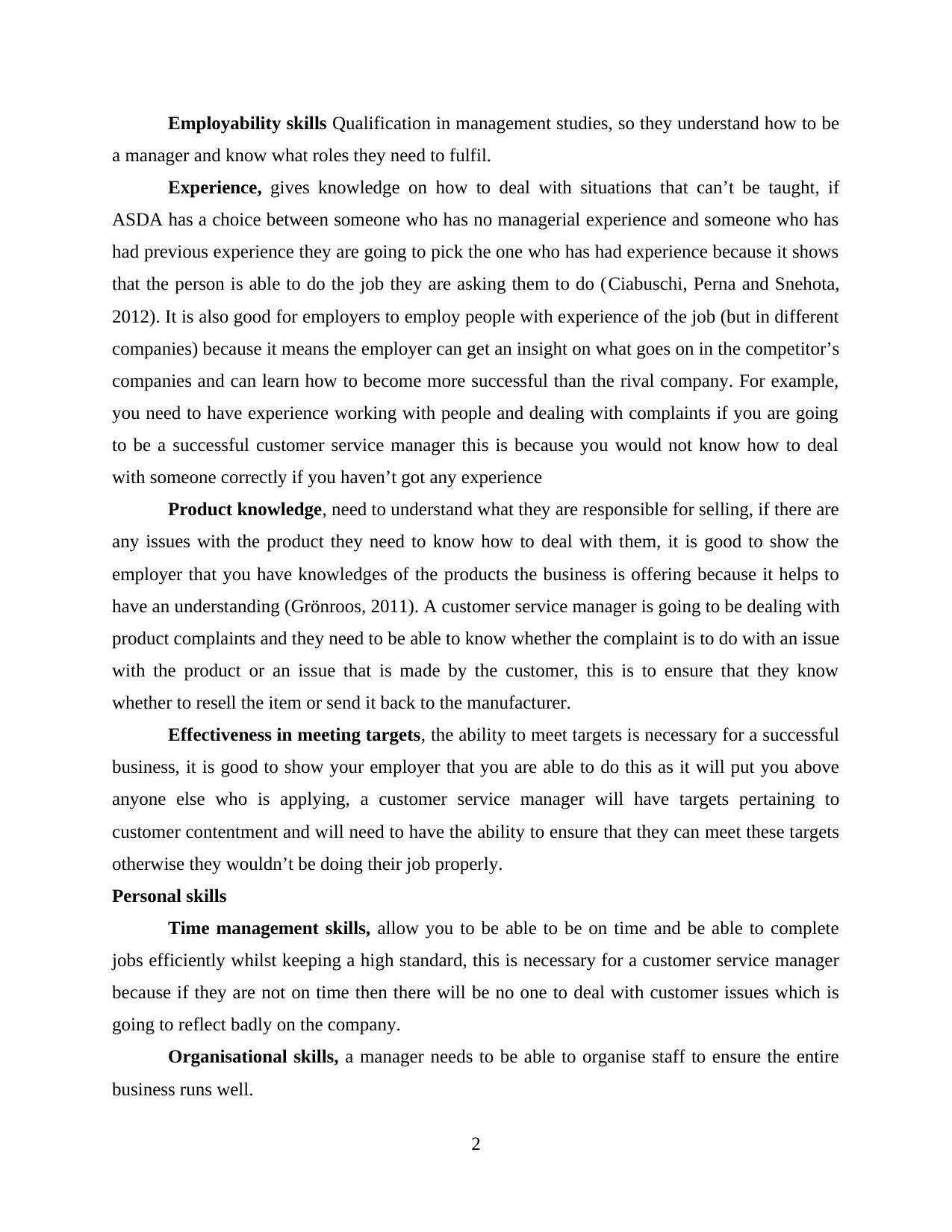
Employability skills Qualification in management studies, so they understand how to be
a manager and know what roles they need to fulfil.
Experience, gives knowledge on how to deal with situations that can’t be taught, if
ASDA has a choice between someone who has no managerial experience and someone who has
had previous experience they are going to pick the one who has had experience because it shows
that the person is able to do the job they are asking them to do (Ciabuschi, Perna and Snehota,
2012). It is also good for employers to employ people with experience of the job (but in different
companies) because it means the employer can get an insight on what goes on in the competitor’s
companies and can learn how to become more successful than the rival company. For example,
you need to have experience working with people and dealing with complaints if you are going
to be a successful customer service manager this is because you would not know how to deal
with someone correctly if you haven’t got any experience
Product knowledge, need to understand what they are responsible for selling, if there are
any issues with the product they need to know how to deal with them, it is good to show the
employer that you have knowledges of the products the business is offering because it helps to
have an understanding (Grönroos, 2011). A customer service manager is going to be dealing with
product complaints and they need to be able to know whether the complaint is to do with an issue
with the product or an issue that is made by the customer, this is to ensure that they know
whether to resell the item or send it back to the manufacturer.
Effectiveness in meeting targets, the ability to meet targets is necessary for a successful
business, it is good to show your employer that you are able to do this as it will put you above
anyone else who is applying, a customer service manager will have targets pertaining to
customer contentment and will need to have the ability to ensure that they can meet these targets
otherwise they wouldn’t be doing their job properly.
Personal skills
Time management skills, allow you to be able to be on time and be able to complete
jobs efficiently whilst keeping a high standard, this is necessary for a customer service manager
because if they are not on time then there will be no one to deal with customer issues which is
going to reflect badly on the company.
Organisational skills, a manager needs to be able to organise staff to ensure the entire
business runs well.
2
a manager and know what roles they need to fulfil.
Experience, gives knowledge on how to deal with situations that can’t be taught, if
ASDA has a choice between someone who has no managerial experience and someone who has
had previous experience they are going to pick the one who has had experience because it shows
that the person is able to do the job they are asking them to do (Ciabuschi, Perna and Snehota,
2012). It is also good for employers to employ people with experience of the job (but in different
companies) because it means the employer can get an insight on what goes on in the competitor’s
companies and can learn how to become more successful than the rival company. For example,
you need to have experience working with people and dealing with complaints if you are going
to be a successful customer service manager this is because you would not know how to deal
with someone correctly if you haven’t got any experience
Product knowledge, need to understand what they are responsible for selling, if there are
any issues with the product they need to know how to deal with them, it is good to show the
employer that you have knowledges of the products the business is offering because it helps to
have an understanding (Grönroos, 2011). A customer service manager is going to be dealing with
product complaints and they need to be able to know whether the complaint is to do with an issue
with the product or an issue that is made by the customer, this is to ensure that they know
whether to resell the item or send it back to the manufacturer.
Effectiveness in meeting targets, the ability to meet targets is necessary for a successful
business, it is good to show your employer that you are able to do this as it will put you above
anyone else who is applying, a customer service manager will have targets pertaining to
customer contentment and will need to have the ability to ensure that they can meet these targets
otherwise they wouldn’t be doing their job properly.
Personal skills
Time management skills, allow you to be able to be on time and be able to complete
jobs efficiently whilst keeping a high standard, this is necessary for a customer service manager
because if they are not on time then there will be no one to deal with customer issues which is
going to reflect badly on the company.
Organisational skills, a manager needs to be able to organise staff to ensure the entire
business runs well.
2
Paraphrase This Document
Need a fresh take? Get an instant paraphrase of this document with our AI Paraphraser
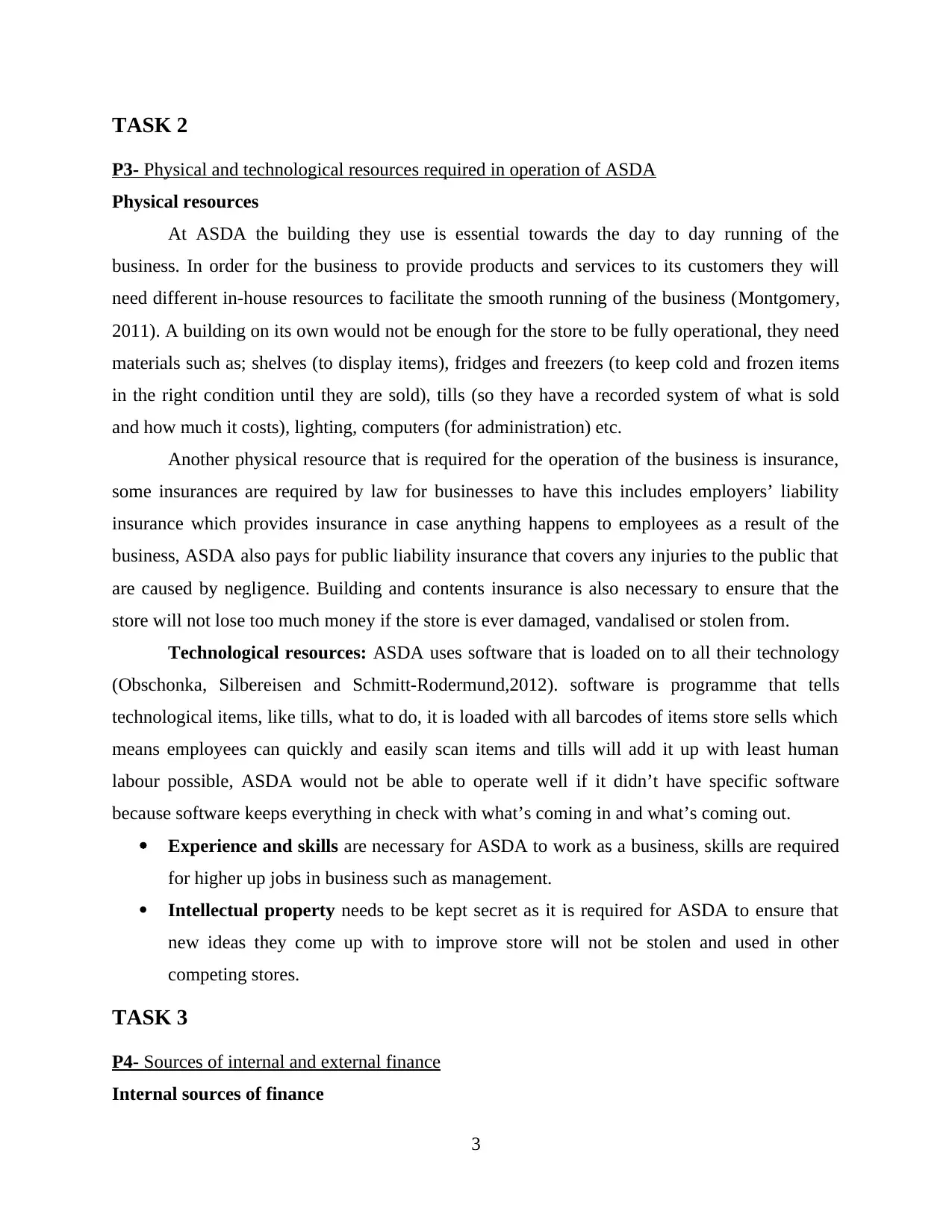
TASK 2
P3- Physical and technological resources required in operation of ASDA
Physical resources
At ASDA the building they use is essential towards the day to day running of the
business. In order for the business to provide products and services to its customers they will
need different in-house resources to facilitate the smooth running of the business (Montgomery,
2011). A building on its own would not be enough for the store to be fully operational, they need
materials such as; shelves (to display items), fridges and freezers (to keep cold and frozen items
in the right condition until they are sold), tills (so they have a recorded system of what is sold
and how much it costs), lighting, computers (for administration) etc.
Another physical resource that is required for the operation of the business is insurance,
some insurances are required by law for businesses to have this includes employers’ liability
insurance which provides insurance in case anything happens to employees as a result of the
business, ASDA also pays for public liability insurance that covers any injuries to the public that
are caused by negligence. Building and contents insurance is also necessary to ensure that the
store will not lose too much money if the store is ever damaged, vandalised or stolen from.
Technological resources: ASDA uses software that is loaded on to all their technology
(Obschonka, Silbereisen and Schmitt‐Rodermund,2012). software is programme that tells
technological items, like tills, what to do, it is loaded with all barcodes of items store sells which
means employees can quickly and easily scan items and tills will add it up with least human
labour possible, ASDA would not be able to operate well if it didn’t have specific software
because software keeps everything in check with what’s coming in and what’s coming out.
Experience and skills are necessary for ASDA to work as a business, skills are required
for higher up jobs in business such as management.
Intellectual property needs to be kept secret as it is required for ASDA to ensure that
new ideas they come up with to improve store will not be stolen and used in other
competing stores.
TASK 3
P4- Sources of internal and external finance
Internal sources of finance
3
P3- Physical and technological resources required in operation of ASDA
Physical resources
At ASDA the building they use is essential towards the day to day running of the
business. In order for the business to provide products and services to its customers they will
need different in-house resources to facilitate the smooth running of the business (Montgomery,
2011). A building on its own would not be enough for the store to be fully operational, they need
materials such as; shelves (to display items), fridges and freezers (to keep cold and frozen items
in the right condition until they are sold), tills (so they have a recorded system of what is sold
and how much it costs), lighting, computers (for administration) etc.
Another physical resource that is required for the operation of the business is insurance,
some insurances are required by law for businesses to have this includes employers’ liability
insurance which provides insurance in case anything happens to employees as a result of the
business, ASDA also pays for public liability insurance that covers any injuries to the public that
are caused by negligence. Building and contents insurance is also necessary to ensure that the
store will not lose too much money if the store is ever damaged, vandalised or stolen from.
Technological resources: ASDA uses software that is loaded on to all their technology
(Obschonka, Silbereisen and Schmitt‐Rodermund,2012). software is programme that tells
technological items, like tills, what to do, it is loaded with all barcodes of items store sells which
means employees can quickly and easily scan items and tills will add it up with least human
labour possible, ASDA would not be able to operate well if it didn’t have specific software
because software keeps everything in check with what’s coming in and what’s coming out.
Experience and skills are necessary for ASDA to work as a business, skills are required
for higher up jobs in business such as management.
Intellectual property needs to be kept secret as it is required for ASDA to ensure that
new ideas they come up with to improve store will not be stolen and used in other
competing stores.
TASK 3
P4- Sources of internal and external finance
Internal sources of finance
3
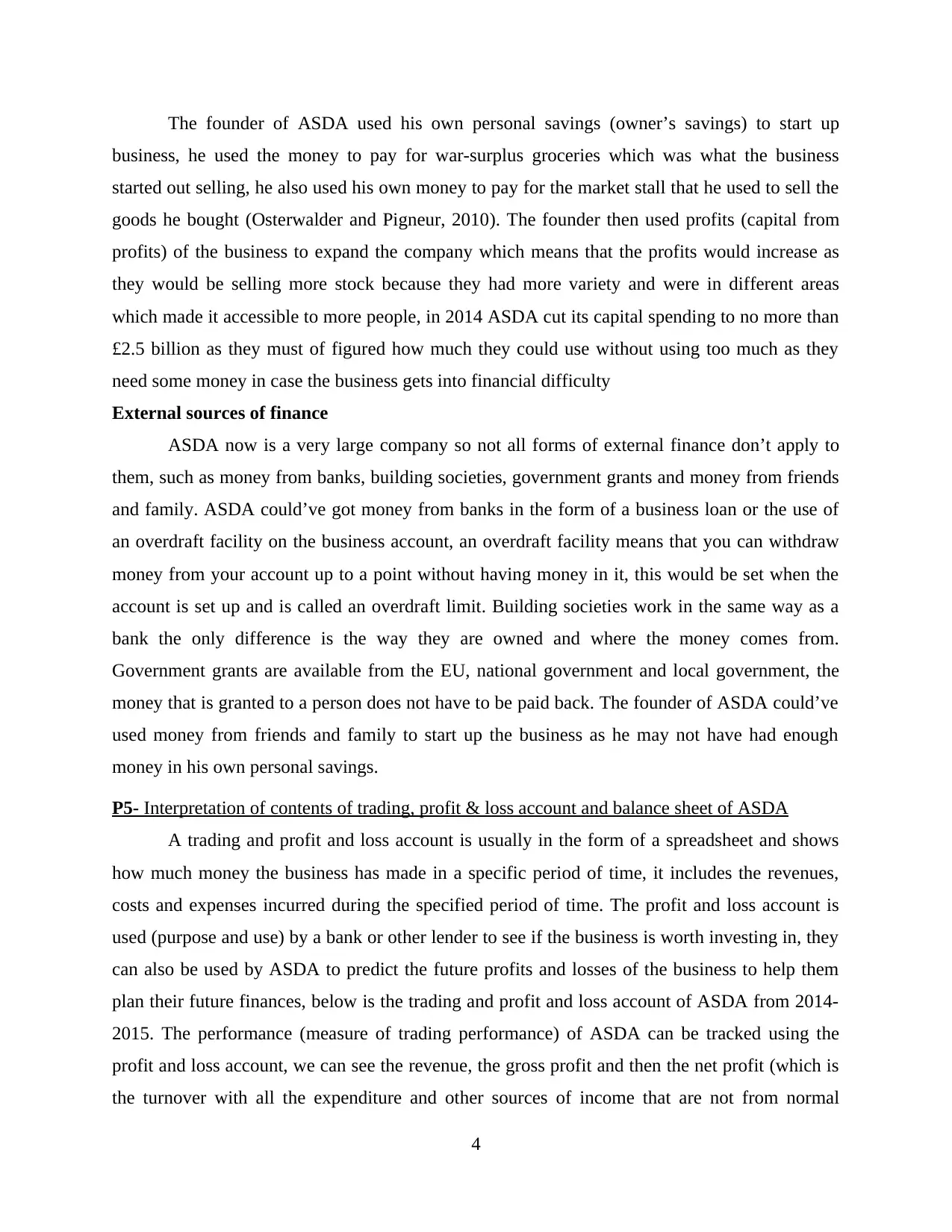
The founder of ASDA used his own personal savings (owner’s savings) to start up
business, he used the money to pay for war-surplus groceries which was what the business
started out selling, he also used his own money to pay for the market stall that he used to sell the
goods he bought (Osterwalder and Pigneur, 2010). The founder then used profits (capital from
profits) of the business to expand the company which means that the profits would increase as
they would be selling more stock because they had more variety and were in different areas
which made it accessible to more people, in 2014 ASDA cut its capital spending to no more than
£2.5 billion as they must of figured how much they could use without using too much as they
need some money in case the business gets into financial difficulty
External sources of finance
ASDA now is a very large company so not all forms of external finance don’t apply to
them, such as money from banks, building societies, government grants and money from friends
and family. ASDA could’ve got money from banks in the form of a business loan or the use of
an overdraft facility on the business account, an overdraft facility means that you can withdraw
money from your account up to a point without having money in it, this would be set when the
account is set up and is called an overdraft limit. Building societies work in the same way as a
bank the only difference is the way they are owned and where the money comes from.
Government grants are available from the EU, national government and local government, the
money that is granted to a person does not have to be paid back. The founder of ASDA could’ve
used money from friends and family to start up the business as he may not have had enough
money in his own personal savings.
P5- Interpretation of contents of trading, profit & loss account and balance sheet of ASDA
A trading and profit and loss account is usually in the form of a spreadsheet and shows
how much money the business has made in a specific period of time, it includes the revenues,
costs and expenses incurred during the specified period of time. The profit and loss account is
used (purpose and use) by a bank or other lender to see if the business is worth investing in, they
can also be used by ASDA to predict the future profits and losses of the business to help them
plan their future finances, below is the trading and profit and loss account of ASDA from 2014-
2015. The performance (measure of trading performance) of ASDA can be tracked using the
profit and loss account, we can see the revenue, the gross profit and then the net profit (which is
the turnover with all the expenditure and other sources of income that are not from normal
4
business, he used the money to pay for war-surplus groceries which was what the business
started out selling, he also used his own money to pay for the market stall that he used to sell the
goods he bought (Osterwalder and Pigneur, 2010). The founder then used profits (capital from
profits) of the business to expand the company which means that the profits would increase as
they would be selling more stock because they had more variety and were in different areas
which made it accessible to more people, in 2014 ASDA cut its capital spending to no more than
£2.5 billion as they must of figured how much they could use without using too much as they
need some money in case the business gets into financial difficulty
External sources of finance
ASDA now is a very large company so not all forms of external finance don’t apply to
them, such as money from banks, building societies, government grants and money from friends
and family. ASDA could’ve got money from banks in the form of a business loan or the use of
an overdraft facility on the business account, an overdraft facility means that you can withdraw
money from your account up to a point without having money in it, this would be set when the
account is set up and is called an overdraft limit. Building societies work in the same way as a
bank the only difference is the way they are owned and where the money comes from.
Government grants are available from the EU, national government and local government, the
money that is granted to a person does not have to be paid back. The founder of ASDA could’ve
used money from friends and family to start up the business as he may not have had enough
money in his own personal savings.
P5- Interpretation of contents of trading, profit & loss account and balance sheet of ASDA
A trading and profit and loss account is usually in the form of a spreadsheet and shows
how much money the business has made in a specific period of time, it includes the revenues,
costs and expenses incurred during the specified period of time. The profit and loss account is
used (purpose and use) by a bank or other lender to see if the business is worth investing in, they
can also be used by ASDA to predict the future profits and losses of the business to help them
plan their future finances, below is the trading and profit and loss account of ASDA from 2014-
2015. The performance (measure of trading performance) of ASDA can be tracked using the
profit and loss account, we can see the revenue, the gross profit and then the net profit (which is
the turnover with all the expenditure and other sources of income that are not from normal
4
⊘ This is a preview!⊘
Do you want full access?
Subscribe today to unlock all pages.

Trusted by 1+ million students worldwide
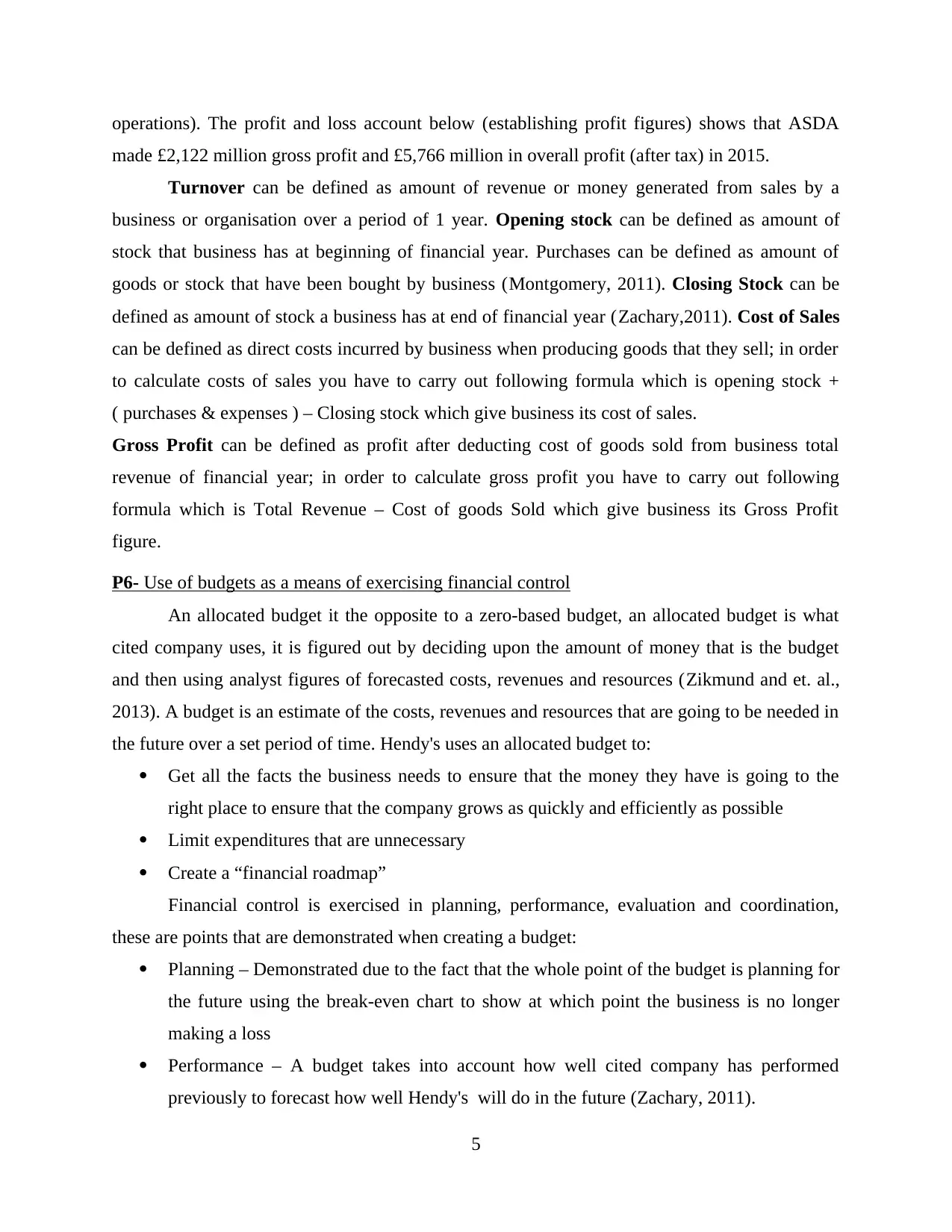
operations). The profit and loss account below (establishing profit figures) shows that ASDA
made £2,122 million gross profit and £5,766 million in overall profit (after tax) in 2015.
Turnover can be defined as amount of revenue or money generated from sales by a
business or organisation over a period of 1 year. Opening stock can be defined as amount of
stock that business has at beginning of financial year. Purchases can be defined as amount of
goods or stock that have been bought by business (Montgomery, 2011). Closing Stock can be
defined as amount of stock a business has at end of financial year (Zachary,2011). Cost of Sales
can be defined as direct costs incurred by business when producing goods that they sell; in order
to calculate costs of sales you have to carry out following formula which is opening stock +
( purchases & expenses ) – Closing stock which give business its cost of sales.
Gross Profit can be defined as profit after deducting cost of goods sold from business total
revenue of financial year; in order to calculate gross profit you have to carry out following
formula which is Total Revenue – Cost of goods Sold which give business its Gross Profit
figure.
P6- Use of budgets as a means of exercising financial control
An allocated budget it the opposite to a zero-based budget, an allocated budget is what
cited company uses, it is figured out by deciding upon the amount of money that is the budget
and then using analyst figures of forecasted costs, revenues and resources (Zikmund and et. al.,
2013). A budget is an estimate of the costs, revenues and resources that are going to be needed in
the future over a set period of time. Hendy's uses an allocated budget to:
Get all the facts the business needs to ensure that the money they have is going to the
right place to ensure that the company grows as quickly and efficiently as possible
Limit expenditures that are unnecessary
Create a “financial roadmap”
Financial control is exercised in planning, performance, evaluation and coordination,
these are points that are demonstrated when creating a budget:
Planning – Demonstrated due to the fact that the whole point of the budget is planning for
the future using the break-even chart to show at which point the business is no longer
making a loss
Performance – A budget takes into account how well cited company has performed
previously to forecast how well Hendy's will do in the future (Zachary, 2011).
5
made £2,122 million gross profit and £5,766 million in overall profit (after tax) in 2015.
Turnover can be defined as amount of revenue or money generated from sales by a
business or organisation over a period of 1 year. Opening stock can be defined as amount of
stock that business has at beginning of financial year. Purchases can be defined as amount of
goods or stock that have been bought by business (Montgomery, 2011). Closing Stock can be
defined as amount of stock a business has at end of financial year (Zachary,2011). Cost of Sales
can be defined as direct costs incurred by business when producing goods that they sell; in order
to calculate costs of sales you have to carry out following formula which is opening stock +
( purchases & expenses ) – Closing stock which give business its cost of sales.
Gross Profit can be defined as profit after deducting cost of goods sold from business total
revenue of financial year; in order to calculate gross profit you have to carry out following
formula which is Total Revenue – Cost of goods Sold which give business its Gross Profit
figure.
P6- Use of budgets as a means of exercising financial control
An allocated budget it the opposite to a zero-based budget, an allocated budget is what
cited company uses, it is figured out by deciding upon the amount of money that is the budget
and then using analyst figures of forecasted costs, revenues and resources (Zikmund and et. al.,
2013). A budget is an estimate of the costs, revenues and resources that are going to be needed in
the future over a set period of time. Hendy's uses an allocated budget to:
Get all the facts the business needs to ensure that the money they have is going to the
right place to ensure that the company grows as quickly and efficiently as possible
Limit expenditures that are unnecessary
Create a “financial roadmap”
Financial control is exercised in planning, performance, evaluation and coordination,
these are points that are demonstrated when creating a budget:
Planning – Demonstrated due to the fact that the whole point of the budget is planning for
the future using the break-even chart to show at which point the business is no longer
making a loss
Performance – A budget takes into account how well cited company has performed
previously to forecast how well Hendy's will do in the future (Zachary, 2011).
5
Paraphrase This Document
Need a fresh take? Get an instant paraphrase of this document with our AI Paraphraser
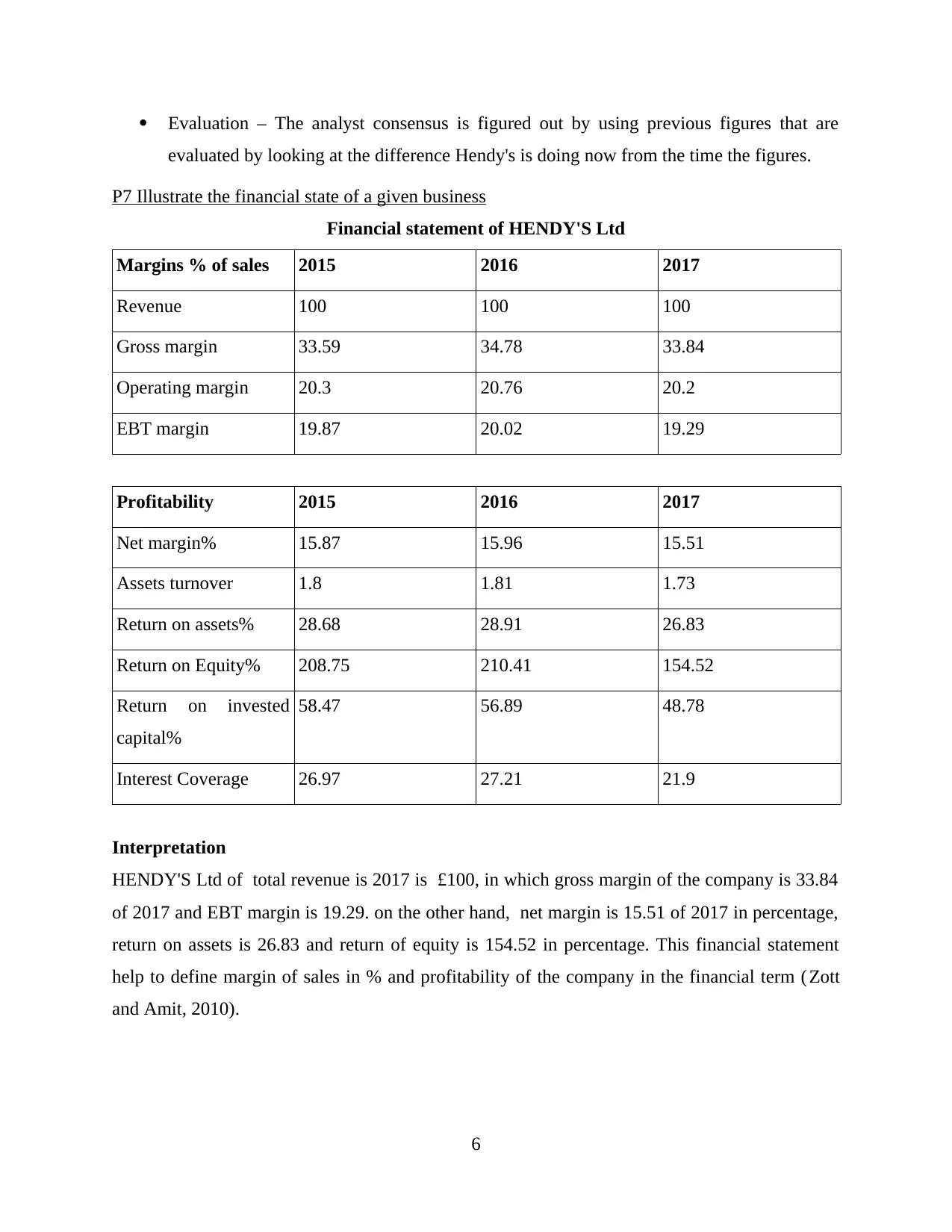
Evaluation – The analyst consensus is figured out by using previous figures that are
evaluated by looking at the difference Hendy's is doing now from the time the figures.
P7 Illustrate the financial state of a given business
Financial statement of HENDY'S Ltd
Margins % of sales 2015 2016 2017
Revenue 100 100 100
Gross margin 33.59 34.78 33.84
Operating margin 20.3 20.76 20.2
EBT margin 19.87 20.02 19.29
Profitability 2015 2016 2017
Net margin% 15.87 15.96 15.51
Assets turnover 1.8 1.81 1.73
Return on assets% 28.68 28.91 26.83
Return on Equity% 208.75 210.41 154.52
Return on invested
capital%
58.47 56.89 48.78
Interest Coverage 26.97 27.21 21.9
Interpretation
HENDY'S Ltd of total revenue is 2017 is £100, in which gross margin of the company is 33.84
of 2017 and EBT margin is 19.29. on the other hand, net margin is 15.51 of 2017 in percentage,
return on assets is 26.83 and return of equity is 154.52 in percentage. This financial statement
help to define margin of sales in % and profitability of the company in the financial term ( Zott
and Amit, 2010).
6
evaluated by looking at the difference Hendy's is doing now from the time the figures.
P7 Illustrate the financial state of a given business
Financial statement of HENDY'S Ltd
Margins % of sales 2015 2016 2017
Revenue 100 100 100
Gross margin 33.59 34.78 33.84
Operating margin 20.3 20.76 20.2
EBT margin 19.87 20.02 19.29
Profitability 2015 2016 2017
Net margin% 15.87 15.96 15.51
Assets turnover 1.8 1.81 1.73
Return on assets% 28.68 28.91 26.83
Return on Equity% 208.75 210.41 154.52
Return on invested
capital%
58.47 56.89 48.78
Interest Coverage 26.97 27.21 21.9
Interpretation
HENDY'S Ltd of total revenue is 2017 is £100, in which gross margin of the company is 33.84
of 2017 and EBT margin is 19.29. on the other hand, net margin is 15.51 of 2017 in percentage,
return on assets is 26.83 and return of equity is 154.52 in percentage. This financial statement
help to define margin of sales in % and profitability of the company in the financial term ( Zott
and Amit, 2010).
6
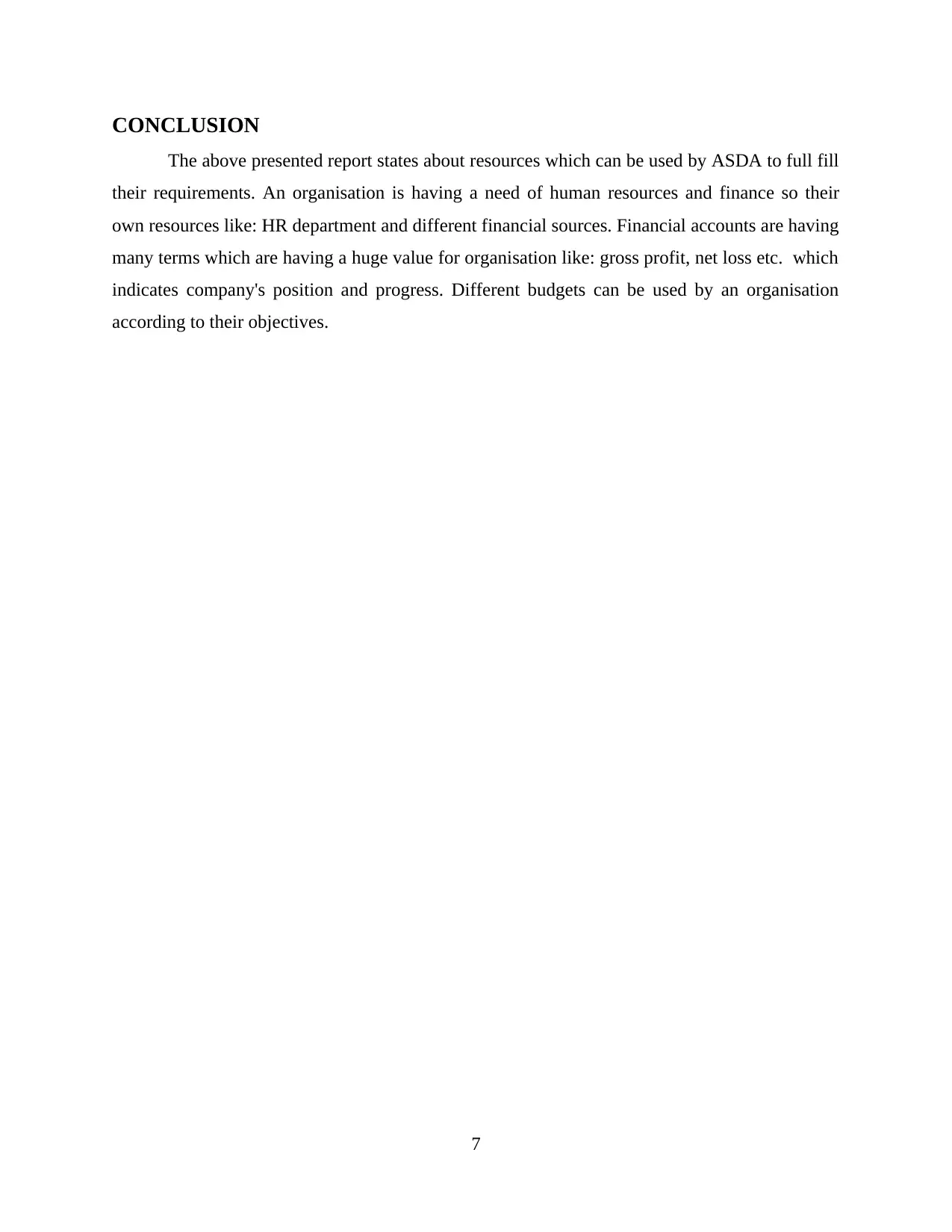
CONCLUSION
The above presented report states about resources which can be used by ASDA to full fill
their requirements. An organisation is having a need of human resources and finance so their
own resources like: HR department and different financial sources. Financial accounts are having
many terms which are having a huge value for organisation like: gross profit, net loss etc. which
indicates company's position and progress. Different budgets can be used by an organisation
according to their objectives.
7
The above presented report states about resources which can be used by ASDA to full fill
their requirements. An organisation is having a need of human resources and finance so their
own resources like: HR department and different financial sources. Financial accounts are having
many terms which are having a huge value for organisation like: gross profit, net loss etc. which
indicates company's position and progress. Different budgets can be used by an organisation
according to their objectives.
7
⊘ This is a preview!⊘
Do you want full access?
Subscribe today to unlock all pages.

Trusted by 1+ million students worldwide
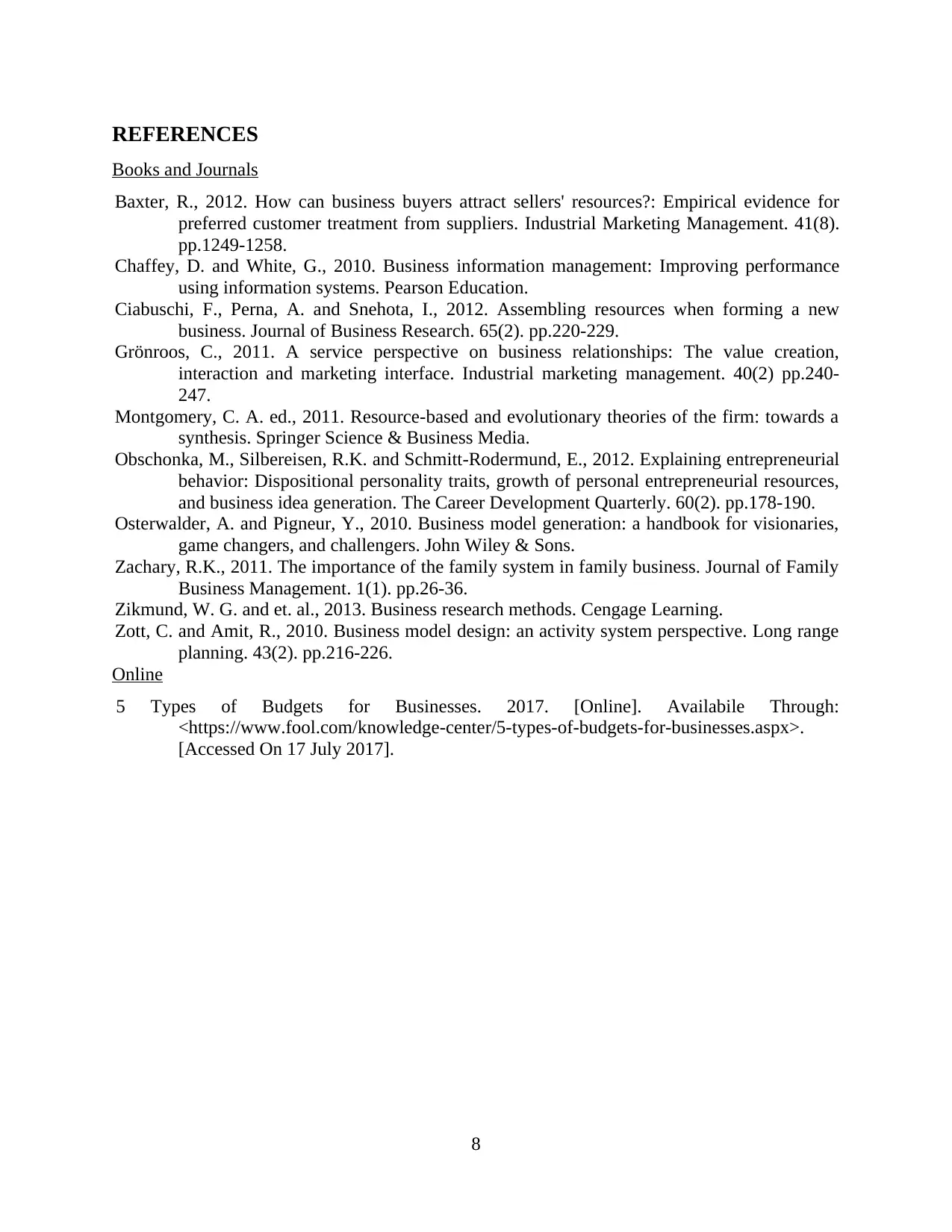
REFERENCES
Books and Journals
Baxter, R., 2012. How can business buyers attract sellers' resources?: Empirical evidence for
preferred customer treatment from suppliers. Industrial Marketing Management. 41(8).
pp.1249-1258.
Chaffey, D. and White, G., 2010. Business information management: Improving performance
using information systems. Pearson Education.
Ciabuschi, F., Perna, A. and Snehota, I., 2012. Assembling resources when forming a new
business. Journal of Business Research. 65(2). pp.220-229.
Grönroos, C., 2011. A service perspective on business relationships: The value creation,
interaction and marketing interface. Industrial marketing management. 40(2) pp.240-
247.
Montgomery, C. A. ed., 2011. Resource-based and evolutionary theories of the firm: towards a
synthesis. Springer Science & Business Media.
Obschonka, M., Silbereisen, R.K. and Schmitt‐Rodermund, E., 2012. Explaining entrepreneurial
behavior: Dispositional personality traits, growth of personal entrepreneurial resources,
and business idea generation. The Career Development Quarterly. 60(2). pp.178-190.
Osterwalder, A. and Pigneur, Y., 2010. Business model generation: a handbook for visionaries,
game changers, and challengers. John Wiley & Sons.
Zachary, R.K., 2011. The importance of the family system in family business. Journal of Family
Business Management. 1(1). pp.26-36.
Zikmund, W. G. and et. al., 2013. Business research methods. Cengage Learning.
Zott, C. and Amit, R., 2010. Business model design: an activity system perspective. Long range
planning. 43(2). pp.216-226.
Online
5 Types of Budgets for Businesses. 2017. [Online]. Availabile Through:
<https://www.fool.com/knowledge-center/5-types-of-budgets-for-businesses.aspx>.
[Accessed On 17 July 2017].
8
Books and Journals
Baxter, R., 2012. How can business buyers attract sellers' resources?: Empirical evidence for
preferred customer treatment from suppliers. Industrial Marketing Management. 41(8).
pp.1249-1258.
Chaffey, D. and White, G., 2010. Business information management: Improving performance
using information systems. Pearson Education.
Ciabuschi, F., Perna, A. and Snehota, I., 2012. Assembling resources when forming a new
business. Journal of Business Research. 65(2). pp.220-229.
Grönroos, C., 2011. A service perspective on business relationships: The value creation,
interaction and marketing interface. Industrial marketing management. 40(2) pp.240-
247.
Montgomery, C. A. ed., 2011. Resource-based and evolutionary theories of the firm: towards a
synthesis. Springer Science & Business Media.
Obschonka, M., Silbereisen, R.K. and Schmitt‐Rodermund, E., 2012. Explaining entrepreneurial
behavior: Dispositional personality traits, growth of personal entrepreneurial resources,
and business idea generation. The Career Development Quarterly. 60(2). pp.178-190.
Osterwalder, A. and Pigneur, Y., 2010. Business model generation: a handbook for visionaries,
game changers, and challengers. John Wiley & Sons.
Zachary, R.K., 2011. The importance of the family system in family business. Journal of Family
Business Management. 1(1). pp.26-36.
Zikmund, W. G. and et. al., 2013. Business research methods. Cengage Learning.
Zott, C. and Amit, R., 2010. Business model design: an activity system perspective. Long range
planning. 43(2). pp.216-226.
Online
5 Types of Budgets for Businesses. 2017. [Online]. Availabile Through:
<https://www.fool.com/knowledge-center/5-types-of-budgets-for-businesses.aspx>.
[Accessed On 17 July 2017].
8
1 out of 10
Related Documents
Your All-in-One AI-Powered Toolkit for Academic Success.
+13062052269
info@desklib.com
Available 24*7 on WhatsApp / Email
![[object Object]](/_next/static/media/star-bottom.7253800d.svg)
Unlock your academic potential
Copyright © 2020–2025 A2Z Services. All Rights Reserved. Developed and managed by ZUCOL.




